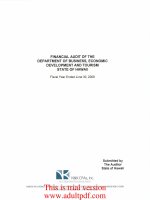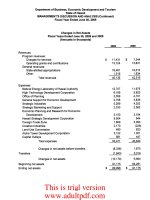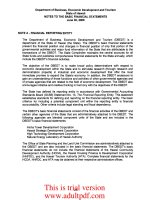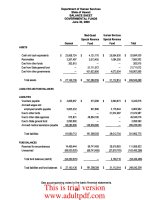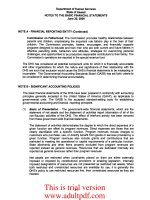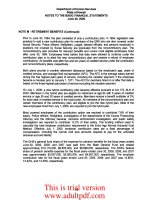Department of Human Services Financial Audit For the Fiscal Year Ended June 30, 1998 March 1999 Financial Audit Division Office of the Legislative Auditor State of Minnesota_part1 pot
Bạn đang xem bản rút gọn của tài liệu. Xem và tải ngay bản đầy đủ của tài liệu tại đây (217.04 KB, 10 trang )
Department of Human Services
Financial Audit
For the Fiscal Year Ended June 30, 1998
March 1999
Financial Audit Division
Office of the Legislative Auditor
State of Minnesota
99-17
Centennial Office Building, Saint Paul, MN 55155 651/296-4708
SUMMARY
State of Minnesota
Office of the Legislative Auditor
1st Floor Centennial Building
658 Cedar Street • St. Paul, MN 55155
(651)296-1727 • FAX (651)296-4712
TDD Relay: 1-800-627-3529
email:
URL:
Department of Human Services
Financial Audit
For the Fiscal Year Ended June 30, 1998
Public Release Date: March 12, 1999 No. 99-17
Agency Background
The Department of Human Services (DHS) administers a variety of programs that provide financial and medical
assistance to eligible Minnesotans. The department administers an annual budget of nearly $5 billion, including
over $2 billion of federal funds. The largest program, Medical Assistance, is the state’s Medicaid program.
The department provides other aid as cash benefits or food stamps. Mr. Michael O’Keefe was named the new
commissioner in January 1999.
Audit Scope and Conclusions
Our audit scope was limited to the activities material to the State of Minnesota’s general purpose financial
statements for the year ended June 30, 1998. Our primary audit objective was to render an opinion on the State
of Minnesota’s financial statements. We also performed audit procedures to determine whether the Department
of Human Services complied with the types of compliance requirements applicable to each of its major federal
programs. The scope within the department included health care program grants (Medical Assistance, General
Assistance Medical Care, and MinnesotaCare), income maintenance programs (Temporary Assistance to Needy
Families and Food Stamps), other grants (Community Social Services, Chemical Dependency Treatment, Child
Support Enforcement, Substance Abuse Prevention, Social Services Block, and Programs for the Aging), as
well as material department revenue programs (Residential Treatment Center and Chemical Dependency Cost
of Care Revenues, the Medical Provider Surcharge, and Child Support Collections).
We qualified our report, dated December 1, 1998, on the State of Minnesota’s general purpose financial
statements because insufficient audit evidence exists to support the State of Minnesota’s disclosures with
respect to the year 2000. Auditing the state’s year 2000 compliance efforts was not an objective of this audit.
As a result, we do not provide assurance that the Department of Human Services is or will be year 2000 ready,
that its year 2000 remediation efforts will be successful in whole or in part, or that parties with which the
Department of Human Services does business will be year 2000 ready.
For the areas audited, the Department of Human Services’ financial activities were fairly presented in the
general purpose financial statements of the State of Minnesota’s Comprehensive Annual Financial Report for
the year ended June 30, 1998. However, we found that the department did not ensure that certain legally
required fund transfers were made.
For the federal programs tested, we found several instances of noncompliance with the types of compliance
requirements described in the U.S. Office of Management and Budget (OMB ) Circular A-133 Compliance
Supplement that are applicable to each of its major federal programs for the year ended June 30, 1998. We
found that the department did not audit the required number of nursing homes during fiscal year 1998,
submitted inaccurate food stamps reports to the federal government, did not have a sufficient system to account
for the Drug Rebate Program, did not have a process to determine suspended or debarred vendors, did not
resolve subrecipient audit reports timely, and did not accurately calculate outstanding interest on federal cash.
In its response, the Department of Human Services agreed with the report’s findings and recommendations and
is taking corrective actions to resolve the issues.
Department of Human Services
Table of Contents
Page
Management Letter 1
Status of Prior Audit Issues 9
Response from the Department of Human Services 11
Audit Participation
The following members of the Office of the Legislative Auditor prepared this report:
Claudia Gudvangen, CPA Deputy Legislative Auditor
Jeanine Leifeld, CPA, CISA Audit Manager
Michael Hassing Auditor-in-Charge
Steve Johnson, CPA Senior Auditor
Pat Ryan Senior Auditor
Connie Stein Senior Auditor
Keith Bispala Staff Auditor
Jill Weber Staff Auditor
Eric Roggeman Intern
Exit Conference
We discussed the findings and recommendations in this report with the following staff of the
Department of Human Services on February 26, 1999::
Tom Moss Acting Commissioner
Dennis Erickson Assistant Commissioner
Jon Darling Director of Financial Management
David Ehrhardt Director of Internal Audit
Phillip Ohman Accounting Manager
STATE OF MINNESOTA
OFFICE OF THE LEGISLATIVE AUDITOR
JAMES R. NOBLES, LEGISLATIVE AUDITOR
Representative Dan McElroy, Chair
Legislative Audit Commission
Members of the Legislative Audit Commission
Mr. Michael O’Keefe, Commissioner
Department of Human Services
We have performed certain audit procedures at the Department of Human Services as part of our
audit of the financial statements of the State of Minnesota as of and for the year ended June 30,
1998. We also have audited certain federal financial assistance programs administered by the
Department of Human Services as part of our audit of the state’s compliance with the
requirements described in the U.S. Office of Management and Budget (OMB) Circular A-133
Compliance Supplement that are applicable to each of its major federal programs for the year
ended June 30, 1998. We emphasize that this has not been a comprehensive audit of the
Department of Human Services.
Table 1-1 identifies the financial activities within the Department of Human Services that were
material to the state’s financial statements. We performed certain audit procedures on these
Department of Human Services programs as part of our objective to obtain reasonable assurance
about whether the State of Minnesota’s financial statements for the year ended June 30, 1998,
were free of material misstatement.
Table 1-1
Programs Material to the State’s Financial Statements
Fiscal Year 1998
(in thousands)
Amount
Revenue Areas
Residential Treatment Center Cost of Care $127,253
Medical Provider Surcharge 123,161
Chemical Dependency Cost of Care 12,756
Child Support Collections 318,597
Expenditure Areas
Medical Assistance $3,055,829
General Assistance Medical Care 119,366
MinnesotaCare 87,773
PST Alternative Care 46,577
Day Treatment and Habilitation 80,709
Temporary Assistance to Needy Families 287,415
Food Stamps 171,895
Food Stamps Administration 39,470
Community Social Services 54,269
Consolidated Chemical Dependency Treatment 60,267
Source: State of Minnesota Comprehensive Annual Financial Report and Minnesota Accounting and Procurement System (MAPS)
for fiscal year 1998.
1ST FLOOR SOUTH, CENTENNIAL BUILDING 658 CEDAR STREET ST. PAUL, MN 55155
TELEPHONE 651/296-4708 TDD RELAY 651/297-5353 FAX 651/296-4712 WEB SITE
Department of Human Services
2
We also audited certain statutory transfers from the Health Care Access Fund and other
administrative transfers. We reviewed the June 30, 1998 reporting of asset and liability balances
for the State Operated Community Services (SOCS) homes owned and run by the department.
Table 1-2 identifies the State of Minnesota’s major federal programs administered by the
Department of Human Services. We performed certain audit procedures on these Department of
Human Services programs as part of our objective to obtain reasonable assurance about whether
the State of Minnesota complied with the types of compliance requirements that are applicable to
each of its major federal programs.
Table 1-2
Major Federal Programs Administered by the Department of Human Services
Fiscal Year 1998
(in thousands)
Program Name
Federal
State
Total
Medicaid Cluster:
Medical Assistance $1,659,244 $1,396,585 $3,055,829
State Survey & Certification of Providers 3,059 1,074 4,133
Food Stamps Cluster:
Food Stamps 171,895 0 171,895
Food Stamps Administration 31,765 7,705 39,470
Temporary Aid for Needy Families 180,567 106,848 287,415
Child Support Enforcement 56,113 23,928 80,041
Social Services Block Grant 41,803 0 41,803
Substance Abuse Prevention & Treatment 20,580 0 20,580
Aging Cluster:
Special Programs for the Aging – IIIB 6,920 793 7,713
Special Programs for the Aging – IIIC 6,071 2290 8,361
Source: Minnesota Accounting and Procurement System (MAPS) for fiscal year 1998.
We conducted our audit in accordance with generally accepted auditing standards and the
standards applicable to financial audits contained in Government Auditing Standards, issued by
the Comptroller General of the United States.
Conclusions
We qualified our report dated December 1, 1998, on the State of Minnesota’s general purpose
financial statements, because of uncertainties about the potentially adverse effect the year 2000
computer issue may have on state operations. Information technology experts believe that many
computer applications in private businesses and government may fail as a result of data integrity
problems and erroneous calculations beyond December 31, 1999. The state is currently
addressing year 2000 issues related to its computer systems and other electronic equipment.
During fiscal year 1996, the state established the Minnesota Year 2000 Project Office to develop
and monitor the overall statewide effort for executive branch agencies. The project office is
tracking over 1,300 mission-critical applications owned by state agencies. As of September
1998, the project office believed that 75 percent of the applications were compliant or had
completed the necessary modifications. However, because of the unprecedented nature of the
Department of Human Services
3
year 2000 issue, its effects and the success of related remediation efforts will not be fully
determinable until the year 2000 and thereafter.
Auditing the state’s year 2000 compliance efforts was not an objective of this audit. As a result,
we do not provide assurance that the Department of Human Services is or will be year 2000
ready, that its year 2000 remediation efforts will be successful in whole or in part, or that parties
with which the Department of Human Services does business will be year 2000 ready.
In accordance with Government Auditing Standards, we have also issued our report, dated
December 1, 1998, on our consideration of the State of Minnesota’s internal control over
financial reporting and our tests of its compliance with certain provisions of laws, regulations,
contracts, and grants. At a later date, we will issue our report on compliance with requirements
applicable to each major federal program and internal control over compliance in accordance
with OMB Circular A-133.
For the areas audited, the Department of Human Services financial activities were fairly
presented in the general purpose financial statements of the State of Minnesota’s Comprehensive
Annual Financial Report for the year ended June 30, 1998. However, we found the following
instances of noncompliance with finance-related legal provisions or the types of compliance
requirements described in the U.S. Office of Management and Budget (OMB) Circular A-133
Compliance Supplement that are applicable to each of its major federal programs for the year
ended June 30, 1998.
1. The Department of Human Services did not ensure that required transfers from the
Health Care Access Fund to the General Fund were made during fiscal year 1998.
Three required transfers totaling $18,480,000 from the Health Care Access Fund to the General
Fund were not made during fiscal year 1998. Laws of Minnesota 1998, Chapter 407, Article 1,
Section 2, Subdivision 3 specifically requires the Human Services commissioner to transfer
$13,700,000 from the Health Care Access Fund to the General Fund to offset a projected savings
to the General Assistance Medical Care Program. Laws of Minnesota 1997, Chapter 225, Article
7, Section 2, Subd. 1 and Section 3 contain a more general requirement to make transfers,
without specifically naming the Human Services commissioner. The Department of Finance
ultimately made the required transfers in November 1998. The Department of Human Services
should work with the Department of Finance to make sure that all transfers are done timely. This
would ensure that the department’s financial activities are accurately presented in the state’s
accounting system and also in the state’s financial statements.
Recommendation
• The Department of Human Services should ensure that the transfers from the
Health Care Access Fund to the General Fund are made on a timely basis in
compliance with applicable legal citations.
Department of Human Services
4
2. The Department of Human Services did not audit the required number of nursing
homes during fiscal year 1998.
The department did not audit the minimum number of nursing home cost reports as required by
statute and by the state plan for medical assistance. The department audited the cost reports at 60
of 413 homes during the fiscal year, or approximately 14.5 percent of all homes. The federal
government requires the state to audit nursing homes that provide services to medical assistance
participants. The state plan is the agreement approved by the federal government that
specifically delineates the rules for these audits. In the state plan, the Department of Human
Services agreed to audit the cost reports of at least 24 percent of the nursing homes in the state
whose residents received medical assistance during fiscal year 1998.
In addition, the state plan conflicts with Minnesota statutes concerning nursing home cost report
auditing. Although the state plan requires 24 percent of nursing homes participating as vendors
of medical assistance to have on-site audits of cost reports each year, Minn. Stat. Section
256B.27 Subd.2a requires only15 percent of the homes to be audited. The statute was revised in
1995; however, the department did not make any changes to the state plan at that time.
Recommendations
• The department should comply with the provisions of the state plan and
perform audit work at the required number of nursing home facilities.
• The department should make the necessary changes to ensure that the state
plan for medical assistance is consistent with applicable state law regarding
nursing home audits.
3. The Department of Human Services submitted inaccurate food stamps reports to the
federal government.
The Department of Human Services did not submit accurate reports to the federal government
for food stamp issuances during part of fiscal year 1998. The department must report to the
federal government on a monthly basis the amount of food stamp allocations issued through the
electronic benefit transfer system. The department uses its MAXIS computer system to
accumulate recipient data and calculate the income maintenance benefits available to recipients.
However, due to programming changes the department needed to make to accommodate welfare
reform, the system was not able to produce the required information for reporting purposes
during part of fiscal year 1998. Therefore, the department filed inaccurate reports with the
federal government.
Recommendation
• The department should correct and resubmit the food stamp reports which
were based on incorrect data during fiscal year 1998.
Department of Human Services
5
4. PRIOR FINDING NOT RESOLVED: The Department of Human Services did not
have a sufficient system of account for the Drug Rebate Program.
The department’s drug rebate record keeping system lacks certain accounting functions to allow
it to perform all functions necessary for the drug rebate program. This federal program requires
drug labelers to rebate a part of the drug retail price to the Medicaid agencies for drugs
purchased through the Medicaid (Medical Assistance) Program. The rebates result from the
difference between normal retail costs and the negotiated contract prices. Rebates collected
during fiscal year 1998 totaled $34,859,916.
The drug rebate unit maintained spreadsheets to accumulate drug rebate financial data. It
received program information from various sources. The MMIS II computer system provided
the unit with the quarterly billable drug rebate amounts. MMIS II calculated these amounts
based on paid pharmacy claims during the quarter and the unit rebate amount for each drug sold.
The drug rebate analyst posts drug rebate collections to spreadsheets and another person verifies
drug rebate payment and adjustment information to the spreadsheet. The department’s Financial
Management Unit recorded the drug rebate collections into the state's accounting system
(MAPS).
The department did not monitor drug labelers for outstanding rebate amounts or charge interest
on past due bills. The department sent quarterly bills to labelers only for the current quarter and
did not include previously billed unpaid amounts. The department had outstanding rebate
billings dating to 1991, the start of the program. Because of the inherent weaknesses in the
current system to account for drug rebates, it is difficult to determine how much of the
outstanding billings are still valid and collectible receivables.
Recommendations
• The Department of Human Services should develop or obtain an accounting
system for the Drug Rebate Program. The system should allow for:
periodic verification of the billing and receipt transactions affecting the
accounts receivable balances, and
the identification of all outstanding drug rebate billings and collected
amounts.
• The department should bill drug labelers for past due balances and should
charge interest on these amounts.
5. PRIOR FINDING NOT RESOLVED: The Department of Human Services did not
have a process to determine suspended or debarred vendors.
The department did not have a process to determine whether a potential vendor had been
suspended or debarred by the federal government prior to obligating federal funds. Federal
Regulation 45CFR92.35 prohibits the state from purchasing items with federal money from
vendors who have been suspended or debarred by the federal government. Vendors are
suspended or debarred when the federal government determines, or is informed, that the vendors
Department of Human Services
6
have abused the public trust, perhaps by violating program provisions. The federal government
expects every state to know who the suspended and debarred vendors are and have a process in
place to prevent them from receiving federal funds.
We first reported this issue to the department in our fiscal year 1997 audit report. At that time,
the department’s purchasing personnel were unaware of the federal restrictions related to the
payment of federal funds to suspended or debarred vendors. The department believes that the
state’s central purchasing function should be responsible for obtaining the certifications from
vendors awarded contracts of $100,000 or more, rather than individual state agencies. We agree
that a central process for obtaining these certifications is a viable option for the state.
Recommendation
• The department should ensure that federal funds are not being paid to vendors
who are suspended or debarred by the federal government.
6. The Department of Human Services did not resolve subrecipient noncompliance timely.
The department did not ensure that corrective actions were taken by subgrantees when audit
reports identified instances of noncompliance with federal policies. The federal government
requires certain subgrantees, based on the materiality of the funds they receive, to have a federal
compliance audit in conjunction with their financial statement audit. Subgrantees submit these
audit reports to the department’s internal audit unit. That unit has the responsibility to review the
subgrantee reports, determine whether there are any instances of noncompliance with federal
policies, and monitor and ensure that corrective action is taken to correct the weakness. The
Department of Finance has a policy that requires the subrecipient's corrective action be taken
within six months after the department receives the audit report.
The department reviewed most of the audit reports it received during fiscal year 1998 and
eliminated the backlog of unreviewed reports from prior years. However, the department did not
issue sanctions for those subrecipients cited for noncompliance.
Recommendation
• To ensure compliance with federal regulations and state policy, the
department needs to monitor that subrecipients correct instances of
noncompliance or impose sanctions against unresponsive subrecipients.
7. The Department of Human Services did not accurately calculate outstanding interest on
federal cash.
The department has used incorrect calculations on its reports of federal interest due and owing.
The department is one of several state agencies with federal programs covered by the agreement
that the Department of Finance entered into with the United States Department of the Treasury.
The agreement sets forth guidelines that are to be followed in requesting and expending federal
funds. The agreement allows the state to charge the federal government interest on funds
received late, and conversely, requires the state to pay interest on funds not expended promptly.
Department of Human Services
7
The Department of Finance determines the statewide total of interest due and owing, based on
interest reports submitted by state agencies.
The department did not accurately calculate outstanding interest on federal cash. Our testing of
the expenditure dates reported on the draw down request forms found several errors resulting in
incorrect interest calculations submitted to the Department of Finance. Errors occurred because
the department did not always use the appropriate dates in recording federal expenditures. The
department has developed a system whereby federal program accountants determine when
expenditures are to be processed on MAPS. A federal cash accountant within the department
uses this information to determine when to draw the federal cash and to determine the amount of
interest either owed to or owed from the federal government.
Recommendation
• The department should implement procedures to ensure that program
accountants record actual and accurate expenditure dates on the federal draw
down requests.
This report is intended for the information of the Legislative Audit Commission and the
management of the Department of Human Services. This restriction is not intended to limit the
distribution of this report, which was released as a public document on March 12, 1999.
James R. Nobles Claudia J. Gudvangen
Legislative Auditor Deputy Legislative Auditor
End of Fieldwork: January 29, 1999
Report Signed On: March 8, 1999
